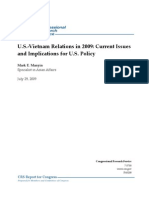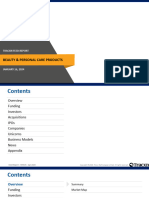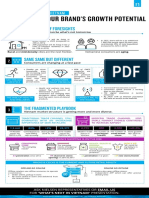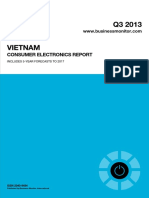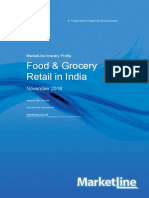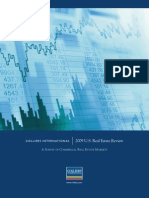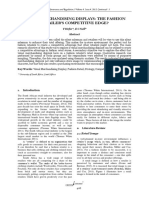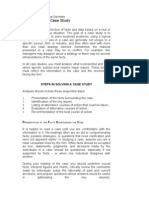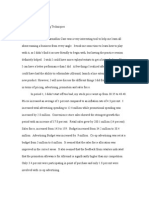Vietnam Apparel Retail 71829
Vietnam Apparel Retail 71829
Uploaded by
Kyle Osbert TolentinoCopyright:
Available Formats
Vietnam Apparel Retail 71829
Vietnam Apparel Retail 71829
Uploaded by
Kyle Osbert TolentinoOriginal Title
Copyright
Available Formats
Share this document
Did you find this document useful?
Is this content inappropriate?
Copyright:
Available Formats
Vietnam Apparel Retail 71829
Vietnam Apparel Retail 71829
Uploaded by
Kyle Osbert TolentinoCopyright:
Available Formats
A Progressive Digital Media business
MarketLine Industry Profile
Apparel Retail in
Vietnam
November 2018
Reference Code: 0124-2005
Publication Date: November 2018
WWW.MARKETLINE.COM
MARKETLINE. THIS PROFILE IS A LICENSED PRODUCT AND IS NOT TO BE PHOTOCOPIED
Vietnam - Apparel Retail 0124 - 2005 - 2017
© MARKETLINE THIS PROFILE IS A LICENSED PRODUCT AND IS NOT TO BE PHOTOCOPIED Page | 1
EXECUTIVE SUMMARY
Market value
The Vietnamese apparel retail industry grew by 13.8% in 2017 to reach a value of $7,576.3 million.
Market value forecast
In 2022, the Vietnamese apparel retail industry is forecast to have a value of $13,310.1 million, an increase of 75.7%
since 2017.
Category segmentation
Childrenswear is the largest segment of the apparel retail industry in Vietnam, accounting for 49.7% of the industry's total
value.
Geography segmentation
Vietnam accounts for 1.4% of the Asia-Pacific apparel retail industry value.
Market rivalry
The presence of strong incumbents and relative lack of diversification in this industry increases the competition between
players. However, strong growth in Vietnam alleviates the degree of rivalry between players and reduces the likelihood of
a zero-sum game.
Vietnam - Apparel Retail 0124 - 2005 - 2017
© MARKETLINE THIS PROFILE IS A LICENSED PRODUCT AND IS NOT TO BE PHOTOCOPIED Page | 2
TABLE OF CONTENTS
Executive Summary......................................................................................................................................................... 2
Market value ................................................................................................................................................................ 2
Market value forecast .................................................................................................................................................. 2
Category segmentation ............................................................................................................................................... 2
Geography segmentation ............................................................................................................................................ 2
Market rivalry ............................................................................................................................................................... 2
Market Overview.............................................................................................................................................................. 7
Market definition .......................................................................................................................................................... 7
Market analysis............................................................................................................................................................ 7
Market Data ..................................................................................................................................................................... 9
Market value ................................................................................................................................................................ 9
Market Segmentation .................................................................................................................................................... 10
Category segmentation ............................................................................................................................................. 10
Geography segmentation .......................................................................................................................................... 11
Market distribution ..................................................................................................................................................... 12
Market Outlook .............................................................................................................................................................. 13
Market value forecast ................................................................................................................................................ 13
Five Forces Analysis ..................................................................................................................................................... 14
Summary ................................................................................................................................................................... 14
Buyer power .............................................................................................................................................................. 15
Supplier power........................................................................................................................................................... 17
New entrants ............................................................................................................................................................. 19
Threat of substitutes .................................................................................................................................................. 21
Degree of rivalry ........................................................................................................................................................ 22
Leading Companies....................................................................................................................................................... 24
Fast Retailing Co., Ltd. .............................................................................................................................................. 24
The Blues .................................................................................................................................................................. 27
Vingroup Joint Stock Co ............................................................................................................................................ 28
Zalora Ltd .................................................................................................................................................................. 32
Macroeconomic Indicators............................................................................................................................................. 33
Vietnam - Apparel Retail 0124 - 2005 - 2017
© MARKETLINE THIS PROFILE IS A LICENSED PRODUCT AND IS NOT TO BE PHOTOCOPIED Page | 3
Country data .............................................................................................................................................................. 33
Methodology .................................................................................................................................................................. 35
Industry associations ................................................................................................................................................. 36
Related MarketLine research .................................................................................................................................... 36
Appendix........................................................................................................................................................................ 37
About MarketLine ...................................................................................................................................................... 37
Vietnam - Apparel Retail 0124 - 2005 - 2017
© MARKETLINE THIS PROFILE IS A LICENSED PRODUCT AND IS NOT TO BE PHOTOCOPIED Page | 4
LIST OF TABLES
Table 1: Vietnam apparel retail industry value: $ million, 2013–17 .................................................................................9
Table 2: Vietnam apparel retail industry category segmentation: $ million, 2017 .........................................................10
Table 3: Vietnam apparel retail industry geography segmentation: $ million, 2017 ......................................................11
Table 4: Vietnam apparel retail industry distribution: % share, by value, 2017 .............................................................12
Table 5: Vietnam apparel retail industry value forecast: $ million, 2017–22 .................................................................13
Table 6: Fast Retailing Co., Ltd.: key facts....................................................................................................................24
Table 7: Fast Retailing Co., Ltd.: key financials ($) .......................................................................................................25
Table 8: Fast Retailing Co., Ltd.: key financials (¥) .......................................................................................................25
Table 9: Fast Retailing Co., Ltd.: key financial ratios ....................................................................................................25
Table 10: The Blues: key facts ...................................................................................................................................... 27
Table 11: Vingroup Joint Stock Co: key facts................................................................................................................28
Table 12: Vingroup Joint Stock Co: key financials ($) ...................................................................................................29
Table 13: Vingroup Joint Stock Co: key financials (VND) .............................................................................................30
Table 14: Vingroup Joint Stock Co: key financial ratios ................................................................................................30
Table 15: Zalora Ltd: key facts ...................................................................................................................................... 32
Table 16: Vietnam size of population (million), 2013–17...............................................................................................33
Table 17: Vietnam gdp (constant 2005 prices, $ billion), 2013–17................................................................................33
Table 18: Vietnam gdp (current prices, $ billion), 2013–17 ...........................................................................................33
Table 19: Vietnam inflation, 2013–17 ............................................................................................................................ 34
Table 20: Vietnam consumer price index (absolute), 2013–17 .....................................................................................34
Table 21: Vietnam exchange rate, 2013–17..................................................................................................................34
Vietnam - Apparel Retail 0124 - 2005 - 2017
© MARKETLINE THIS PROFILE IS A LICENSED PRODUCT AND IS NOT TO BE PHOTOCOPIED Page | 5
LIST OF FIGURES
Figure 1: Vietnam apparel retail industry value: $ million, 2013–17 ................................................................................9
Figure 2: Vietnam apparel retail industry category segmentation: % share, by value, 2017.........................................10
Figure 3: Vietnam apparel retail industry geography segmentation: % share, by value, 2017......................................11
Figure 4: Vietnam apparel retail industry distribution: % share, by value, 2017............................................................12
Figure 5: Vietnam apparel retail industry value forecast: $ million, 2017–22 ................................................................13
Figure 6: Forces driving competition in the apparel retail industry in Vietnam, 2017 ....................................................14
Figure 7: Drivers of buyer power in the apparel retail industry in Vietnam, 2017 ..........................................................15
Figure 8: Drivers of supplier power in the apparel retail industry in Vietnam, 2017 ......................................................17
Figure 9: Factors influencing the likelihood of new entrants in the apparel retail industry in Vietnam, 2017 ................19
Figure 10: Factors influencing the threat of substitutes in the apparel retail industry in Vietnam, 2017........................21
Figure 11: Drivers of degree of rivalry in the apparel retail industry in Vietnam, 2017 ..................................................22
Figure 12: Fast Retailing Co., Ltd.: revenues & profitability ..........................................................................................26
Figure 13: Fast Retailing Co., Ltd.: assets & liabilities ..................................................................................................26
Figure 14: Vingroup Joint Stock Co: revenues & profitability ........................................................................................30
Figure 15: Vingroup Joint Stock Co: assets & liabilities ................................................................................................31
Vietnam - Apparel Retail 0124 - 2005 - 2017
© MARKETLINE THIS PROFILE IS A LICENSED PRODUCT AND IS NOT TO BE PHOTOCOPIED Page | 6
MARKET OVERVIEW
Market definition
The apparel retail market includes baby clothing, toddler clothing and casual wear, essentials, formalwear, formalwear-
occasion, and outerwear for men, women, boys and girls; excludes sports-specific clothing.
Any currency conversions used in the creation of this report have been calculated using constant 2017 annual average
exchange rates.
For the purposes of this report, the global market consists of North America, South America, Europe, Asia-Pacific, Middle
East, South Africa and Nigeria.
North America consists of Canada, Mexico, and the United States.
South America comprises Argentina, Brazil, Chile, Colombia, and Peru.
Europe comprises Austria, Belgium, the Czech Republic, Denmark, Finland, France, Germany, Greece, Ireland, Italy,
Netherlands, Norway, Poland, Portugal, Russia, Spain, Sweden, Switzerland, Turkey, and the United Kingdom.
Scandinavia comprises Denmark, Finland, Norway, and Sweden.
Asia-Pacific comprises Australia, China, Hong Kong, India, Indonesia, Kazakhstan, Japan, Malaysia, New Zealand,
Pakistan, Philippines, Singapore, South Korea, Taiwan, Thailand, and Vietnam.
Middle East comprises Egypt, Israel, Saudi Arabia, and United Arab Emirates.
Market analysis
The Vietnamese apparel retail industry has experienced strong double digit growth in recent years. This trend is
expected to continue into the forecast period, at a slightly decelerated rate.
The Vietnamese apparel retail industry had total revenues of $7.6bn in 2017, representing a compound annual growth
rate (CAGR) of 13.4% between 2013 and 2017. In comparison, the Kazakh and industry grew with a CAGR of 9.8%, and
the Hong Kong market declined with a compound annual rate of change (CARC) of -1.4% respectively, over the same
period, to reach respective values of $1.9bn and $7bn in 2017.
Owing to the decline in the mining and agriculture sector, along with a slowdown of the Chinese economy which is
Vietnam’s fourth largest trading partner, the real GDP of Vietnam slowed down to 6.2% in 2016. However, economic
growth is still strong and has been fuelled by real household consumption expenditure which increased by 7.2% in 2016,
following a 13.9% increase in 2015. A robust economy has driven growth in the apparel retail industry.
The growing popularity of shopping online is a key factor which has impacted on the apparel retail industry. The
Vietnamese online retail sector grew by 20.7% in 2017 and is expected to increase a further 110.5% by 2022. Customers
have been won over by the convenience, variety and cheaper prices which online apparel retailers can offer. This has
led to growth in the online-pureplay channel which now accounts for 2.7% of the industry’s total value. While this has
helped drive growth in the industry, the prominence of heavy discounting and low prices online has eroded revenue
somewhat.
Internet access and social media use have become more widespread in the country which has encouraged growth in the
online channel. Many Vietnamese people still live in rural areas, therefore online shopping can be an effective way on
finding hard to source items and getting them delivered in a convenient way. As of 2017, only 35.2% of the Vietnamese
population lived in urban areas.
Despite the growing trend of shopping online, specialty retailers remain the dominant channel in Vietnam, accounting for
66.3% of the industry’s value. However, retailers which have implemented a multi-channel approach are able to benefit
from both a physical and online presence, which helps them drive sales.
Vietnam - Apparel Retail 0124 - 2005 - 2017
© MARKETLINE THIS PROFILE IS A LICENSED PRODUCT AND IS NOT TO BE PHOTOCOPIED Page | 7
The childrenswear segment was the industry's most lucrative in 2017, with total revenues of $3.8bn, equivalent to 49.7%
of the industry's overall value. The womenswear segment contributed revenues of $2.7bn in 2017, equating to 35.8% of
the industry's aggregate value.
Fast fashion has also proven to be a lucrative sector in the industry, particularly for the millennial customer. Changes in
consumer spending habits have made Vietnam an attractive location for international companies. International giants
such as H&M and Inditex have opened flagship stores in the country and have experienced a great reception.
The growth in foreign investment in Vietnam is an indication of the confidence that foreign investors have in the country.
This is due to the presence of relatively cheap labor and attractive tax incentives.
The performance of the industry is forecast to decelerate, with an anticipated CAGR of 11.9% for the five-year period
2017 - 2022, which is expected to drive the industry to a value of $13.3bn by the end of 2022. Comparatively, the Kazakh
and Hong Kong industries will grow with CAGRs of 8% and 3.8% respectively, over the same period, to reach respective
values of $2.8bn and $8.5bn in 2022.
Vietnam’s economy is expected to remain robust in the coming years, supported by increased private consumption,
strong private credit growth and rising incomes. This will drive strong growth in the apparel retail industry in the coming
years.
The trend towards increased online spending will only grow over the coming years thanks to its ability to deliver
convenience and unbeatable prices. This will encourage growth in the apparel retail industry but also cause a slight
deceleration over the forecast period as the penetration of online retail sales becomes close to saturation and leads to
increased downward pricing competition. In terms of potential consumers (internet users), the penetration of online
shopping in Vietnam is low, resulting in ample room for growth. Moreover, the increase in the number of internet users
will be further fueled by the growing young-aged population, rising income, and the expansion of broadband in rural
areas.
Vietnam - Apparel Retail 0124 - 2005 - 2017
© MARKETLINE THIS PROFILE IS A LICENSED PRODUCT AND IS NOT TO BE PHOTOCOPIED Page | 8
MARKET DATA
Market value
The Vietnamese apparel retail industry grew by 13.8% in 2017 to reach a value of $7,576.3 million.
The compound annual growth rate of the industry in the period 2013–17 was 13.4%.
Table 1: Vietnam apparel retail industry value: $ million, 2013–17
Year $ million VND million € million % Growth
2013 4,581.4 104,036,700.0 4,047.2
2014 5,196.3 118,001,080.0 4,590.4 13.4%
2015 5,945.5 135,013,580.0 5,252.2 14.4%
2016 6,657.7 151,186,223.5 5,881.3 12.0%
2017 7,576.3 172,045,739.5 6,692.8 13.8%
CAGR: 2013–17 13.4%
SOURCE: MARKETLINE MARKETLINE
Figure 1: Vietnam apparel retail industry value: $ million, 2013–17
SOURCE: MARKETLINE MARKETLINE
Vietnam - Apparel Retail 0124 - 2005 - 2017
© MARKETLINE THIS PROFILE IS A LICENSED PRODUCT AND IS NOT TO BE PHOTOCOPIED Page | 9
MARKET SEGMENTATION
Category segmentation
Childrenswear is the largest segment of the apparel retail industry in Vietnam, accounting for 49.7% of the industry's total
value.
The Womenswear segment accounts for a further 35.8% of the industry.
Table 2: Vietnam apparel retail industry category segmentation: $ million, 2017
Category 2017 %
Childrenswear 3,763.9 49.7%
Womenswear 2,713.8 35.8%
Menswear 1,098.6 14.5%
Total 7,576.3 100%
SOURCE: MARKETLINE MARKETLINE
Figure 2: Vietnam apparel retail industry category segmentation: % share, by value, 2017
SOURCE: MARKETLINE MARKETLINE
Vietnam - Apparel Retail 0124 - 2005 - 2017
© MARKETLINE THIS PROFILE IS A LICENSED PRODUCT AND IS NOT TO BE PHOTOCOPIED Page | 10
Geography segmentation
Vietnam accounts for 1.4% of the Asia-Pacific apparel retail industry value.
China accounts for a further 45.8% of the Asia-Pacific industry.
Table 3: Vietnam apparel retail industry geography segmentation: $ million, 2017
Geography 2017 %
China 240,138.0 45.8
India 54,019.4 10.3
Vietnam 7,576.3 1.4
Hong Kong 7,043.0 1.3
Kazakhstan 1,886.0 0.4
Rest of Asia-Pacific 213,353.3 40.7
Total 524,016 99.9%
SOURCE: MARKETLINE MARKETLINE
Figure 3: Vietnam apparel retail industry geography segmentation: % share, by value, 2017
SOURCE: MARKETLINE MARKETLINE
Vietnam - Apparel Retail 0124 - 2005 - 2017
© MARKETLINE THIS PROFILE IS A LICENSED PRODUCT AND IS NOT TO BE PHOTOCOPIED Page | 11
Market distribution
Clothing, Footwear and Accessories Specialists form the leading distribution channel in the Vietnamese apparel retail
industry, accounting for a 66.3% share of the total industry's value.
Department Stores accounts for a further 17.6% of the industry.
Table 4: Vietnam apparel retail industry distribution: % share, by value, 2017
Channel % Share
Clothing, Footwear and Accessories Specialists 66.3%
Department Stores 17.6%
Hypermarkets, Supermarkets and Hard Discounters 3.5%
Online Retail 2.7%
Other 9.9%
Total 100%
SOURCE: MARKETLINE MARKETLINE
Figure 4: Vietnam apparel retail industry distribution: % share, by value, 2017
SOURCE: MARKETLINE MARKETLINE
Vietnam - Apparel Retail 0124 - 2005 - 2017
© MARKETLINE THIS PROFILE IS A LICENSED PRODUCT AND IS NOT TO BE PHOTOCOPIED Page | 12
MARKET OUTLOOK
Market value forecast
In 2022, the Vietnamese apparel retail industry is forecast to have a value of $13,310.1 million, an increase of 75.7%
since 2017.
The compound annual growth rate of the industry in the period 2017–22 is predicted to be 11.9%.
Table 5: Vietnam apparel retail industry value forecast: $ million, 2017–22
Year $ million VND million € million % Growth
2017 7,576.3 172,045,739.5 6,692.8 13.8%
2018 8,469.7 192,333,542.1 7,482.0 11.8%
2019 9,494.9 215,614,365.1 8,387.7 12.1%
2020 10,614.1 241,029,271.2 9,376.3 11.8%
2021 11,938.3 271,100,750.2 10,546.2 12.5%
2022 13,310.1 302,252,534.8 11,758.0 11.5%
CAGR: 2017–22 11.9%
SOURCE: MARKETLINE MARKETLINE
Figure 5: Vietnam apparel retail industry value forecast: $ million, 2017–22
SOURCE: MARKETLINE MARKETLINE
Vietnam - Apparel Retail 0124 - 2005 - 2017
© MARKETLINE THIS PROFILE IS A LICENSED PRODUCT AND IS NOT TO BE PHOTOCOPIED Page | 13
FIVE FORCES ANALYSIS
The apparel retail market will be analyzed taking retailers as players. The key buyers will be taken as individual
consumers, and clothing manufacturer and wholesalers as the key suppliers.
Summary
Figure 6: Forces driving competition in the apparel retail industry in Vietnam, 2017
SOURCE: MARKETLINE MARKETLINE
The presence of strong incumbents and relative lack of diversification in this industry increases the competition between
players. However, strong growth in Vietnam alleviates the degree of rivalry between players and reduces the likelihood of
a zero-sum game.
Demand patterns are susceptible to branding and advertising, which, despite the lack of significant switching costs, tends
to weaken buyer power. However, despite consumers' lack of a significant financial muscle, the position of retailers at the
end of the value chain makes it impossible to integrate forwards. This means that they are obliged to offer buyers what
they demand, in an industry often subject to unpredictable and rapid changes in fashion.
There is a degree of forward integration amongst the manufacturers of apparel products. Large companies often
manufacture and retail their own products, with the majority of production sites being located in low-cost countries,
notably in Asia.
Low barriers to entry and relatively low requirements for capital mean there is a high likelihood of new entrants in this
industry. De-regulation has made Vietnam an attractive destination for international retailers such as H&M and Inditex.
Substitutes to apparel retail include bespoke tailoring, factory shops, homemade clothing, and second hand clothing,
although these pose a minimal threat to industry players.
Product innovation is constant in the sector and apparel retailers are also increasingly aiming to establish themselves as
lifestyle brands and build athleisure ranges. Retailers continue to fine-tune their promotional strategies, with many
relocating their discounted goods by introducing off-price formats; however this may be damaging in the long term.
Vietnam - Apparel Retail 0124 - 2005 - 2017
© MARKETLINE THIS PROFILE IS A LICENSED PRODUCT AND IS NOT TO BE PHOTOCOPIED Page | 14
Buyer power
Figure 7: Drivers of buyer power in the apparel retail industry in Vietnam, 2017
SOURCE: MARKETLINE MARKETLINE
Buyer power in the apparel retail industry is weakened by the small size of buyers: virtually all buyers are individual
consumers. What's more, retailers tend to have large numbers of individual customers, which further weakens buyer
power as the loss of one customer is unlikely to have a significant impact on revenues.
Despite the fact that brand consciousness in this industry is substantial, the loyalty of consumers to specific brands is not
always the overriding factor in their decision making, which is likely to be influenced more by the products they offer.
Buyer power is enhanced by the high level of choice within the industry and the low cost of switching between different
players, which enables buyers to easily sway from company to company. Brand loyalty is relatively low in the industry
especially amongst international powerhouses; in the top end of the industry loyalty is connected more with specific
designers rather than the retailer as a whole.
The depth of price sensitivity varies regionally, although clothes are perceived as closely linked to lifestyle and social
status, which grants retailers the opportunity to influence consumer behavior. There is a large industry for non-designer
apparel retail, especially among customers with lower disposable incomes as customers in the region are increasingly
favoring off-price stores that offer fashion at an attractive price. This trend has increased buyer power, as many mid-
range apparel retailers have had to mark down prices and offer promotional deals more frequently in order to attract
customers away from low priced retailers such as H&M and Inditex.
Retailers can differentiate themselves through the styles of clothing offered and the price range of this clothing, meaning
buyer power is weakened. For example, if a customer has a preference for casual style clothing their buyer power will be
limited as only certain stores cater to this taste. Price can also be a factor which decreases buyer power, as consumers
who seek garments within a low price range will be limited to shop at fast fashion retailers such as H&M.
Apparel is an essential item for consumers, and they are significantly exposed to the penetration of marking icons and
images into most forms of media. However, retailers must remain aware of the developments that shape public
perception and subsequent demand. Growing sophistication and wide fashion media exposure has changed the
consumer's perception of fashion and raised awareness of trends, thus increasing buyer power.
Vietnam - Apparel Retail 0124 - 2005 - 2017
© MARKETLINE THIS PROFILE IS A LICENSED PRODUCT AND IS NOT TO BE PHOTOCOPIED Page | 15
With the exception of a small number of high net worth individuals, the majority of customer's lack financial muscle and
backwards integration is not a possibility. However, retailers equally are unable to forward integrate, balancing the
equation somewhat.
In an industry that is often subject to unpredictable and rapid changes in fashion, players are obliged to offer buyers what
they demand. This strengthens buyer power.
Overall, buyer power is assessed as moderate.
Vietnam - Apparel Retail 0124 - 2005 - 2017
© MARKETLINE THIS PROFILE IS A LICENSED PRODUCT AND IS NOT TO BE PHOTOCOPIED Page | 16
Supplier power
Figure 8: Drivers of supplier power in the apparel retail industry in Vietnam, 2017
SOURCE: MARKETLINE MARKETLINE
The key suppliers in this industry are clothing manufacturers and wholesalers. These are typically small to medium sized
enterprises, giving retailers the possibility to source from either, depending on what is required. The wholesale and
clothing manufacturing sectors are fairly fragmented. Supplier fragmentation is made greater by the ability of retailers to
source from foreign manufacturers in the aim of keeping costs down.
With the liberalization of international trade, supplier power in the global industry is decreased through competition from
manufacturers in low-wage regions. Despite the increase, minimum wage in Asia remains a fraction of the level in the
developed countries. The threat of oligopoly is low as there is an abundance of suppliers around the globe; however, the
conditions in the Asia-Pacific region have made it a more attractive destination than other regions.
While manufacturing in the Asia-Pacific region is cheaper, Corporate Social Responsibility (CSR) is becoming more
important in the industry and there is a pressure from consumers and non-governmental organizations (NGOs) for
companies to be more transparent in regard to supply chains. For example, the Fashion Transparency Index report
published by NGO Fashion Revolution, ranks apparel companies on the level of supply chain transparency and
governance practices that are employed in their facilities. It has become more important for suppliers to operate in an
ethical way in order to comply with the expectations of players, however, the number of successful CSR performers is
low and suppliers who are successful are in high demand, thus increasing supplier power.
In 2013, a five-story building named Rana Plaza collapsed in Bangladesh, killing over 1,000 and injuring over 2,000
clothing factory workers. The incident put a spotlight on the unethical and unsafe working conditions of factory workers
and at the time brought about calls for an overhaul in the supply chains of major fashion retailers. Brands such as
Walmart, Primark, Benetton and Mango all supplied clothing from Rana Plaza. Despite the fact that some of the big
brands have made some positive steps to create more ethical supply chains, this has not been enough and many
workers still face abhorrent conditions in garment factories in many parts of the world. Fast fashion remains increasingly
popular, with consumers attracted by the cheap price regardless of the nature of the supply chain the product came
through; therefore the issue continues to play a role within the apparel retail industry in regard to suppliers.
Although retailers' switching costs are not very high, switching includes the risk of choosing a supplier with a more
extended supply chain or who may not be able to cope with sudden changes in demand on the industry. The lack of
diversity between suppliers weakens their power, as the apparel retail industry is highly important to their business.
Vietnam - Apparel Retail 0124 - 2005 - 2017
© MARKETLINE THIS PROFILE IS A LICENSED PRODUCT AND IS NOT TO BE PHOTOCOPIED Page | 17
Apparel manufacturing is almost always labor intensive, due to the difficulty of automating processes such as the sewing
of garments. The existence of a minimum wage in many countries slightly increases the power of suppliers of labor.
While labor intensity remains high in 'slow' fashion, it is likely that in the future fast fashion companies will make way for
capital-intensive production that focuses on new technology and robotics as a means of production. For example,
Amazon has already patented an automated on-demand clothing factory that is able to make clothes once orders have
been placed. The automation of apparel manufacturing will be encouraged by rising minimum wages in Asia which is
becoming a problem for fast fashion companies and may drive automated production back to places such as Europe and
the US. Suppliers who can adapt to these changes will be in an advantageous position.
There is a degree of forward integration amongst the manufacturers of apparel products. Large companies often
manufacture and retail their own products, with the majority of production sites being located in low-cost countries,
notably in Asia. However, problems related to keeping the production overseas may include: delays, high intellectual
property protection burdens, quality control issues, management overheads, logistics overheads and other hidden costs.
Unlike its rivals, who make their clothing primarily in Asia, Inditex conducts most of its operations in Spain, with 59% of
the company's factories located close to its headquarters in Arteixo in North West Spain, allowing it to make garments
and quickly ship them to Europe, its biggest industry. The company keeps inventory low, shipping products based on
demand. This allows it to take fewer markdowns for things like bad weather and shifting consumer tastes, avoiding the
kind of problems its competitors run into.
Overall, supplier power is assessed as moderate.
Vietnam - Apparel Retail 0124 - 2005 - 2017
© MARKETLINE THIS PROFILE IS A LICENSED PRODUCT AND IS NOT TO BE PHOTOCOPIED Page | 18
New entrants
Figure 9: Factors influencing the likelihood of new entrants in the apparel retail industry in
Vietnam, 2017
SOURCE: MARKETLINE MARKETLINE
In this industry, barriers to entry are not high, with capital requirements being low enough for individuals to enter.
However, a small number of international and domestic players account for a significant share of total industry revenues.
They benefit from scale economies that allow them to build brands in multiple retail outlets and grant them a greater
buying power when negotiating with suppliers. The latter allows them to compete more intensely on price.
There is also rising competition from low price retailers, as well as off-price retailing. In order to satisfy demand for
discounted branded products, the brands either overproduce or repeat last year's designs to ensure the off-price stores
are full. As such players compress consumer prices, traditional retailers will be forced to emphasize low price and low
cost operations. As a result, they will also have to look at their cost structure and decide how to be lean and competitive
in their pricing, staffing, and store count.
Level of government regulation differs from country to country. Some countries have introduced protectionist measures
to support their domestic industries; these include high import tariffs and non-tariff barriers. Such regulations can have a
huge impact on retailers importing their products from foreign suppliers. In other cases, there are trade agreements in
place that allow more apparel into the country at very low prices, increasing imports from the low-cost producing
countries. This in turn forces local producers or other international companies to lower their prices in order to compete,
driving down prices for the entire segment. De-regulation in Vietnam has also encouraged growth in the industry. It was
initiated when the country joined the World Trade Organization in 2007, in which the government relaxed the rules
surrounding new business. The creation of a transparent industry has encouraged new entrants, as the criteria for
establishing a business has become much simpler and clearer. There is little regulation as such for retailers in the
industry, but there are some self-imposed conventions related to child labor, working conditions and workers' wages.
New entrants who are known to have items manufactured outside of such conventions may lose customers and suffer
long-term reputational damage.
The low cost of switching for buyers and the relative lack of differentiation between products mean that it is easier for
new players to compete in Vietnam; this is further encouraged by strong growth within the industry. The gradual
improvement of the Vietnamese economy has had a knock on effect and encouraged growth in the apparel retail industry
as the middle class population has expanded and disposable incomes have risen.
Vietnam - Apparel Retail 0124 - 2005 - 2017
© MARKETLINE THIS PROFILE IS A LICENSED PRODUCT AND IS NOT TO BE PHOTOCOPIED Page | 19
Online fast fashion retailer Asos has experienced strong growth in recent years and has become a global e-commerce
giant; in 2017 its sales surpassed $2.5bn. The company now delivers to 200 countries worldwide and is well known for
offering on trend items for low prices. Two-fifths of its sales are its own-brand products and the company launches 5,000
new products on its site every week, at any one time the company has around 85,000 products available to purchase.
Asos have utilized the online shopping trend to increase sales and have invested heavily in technology and site
accessibility on mobile devices. The introduction of free delivery and returns in certain regions has made shopping at
Asos much more convenient than other online retailers and innovative offerings such as same day delivery and 'buy now
pay later' options have proven popular with consumers. An efficient global shipping strategy and e-commerce localization
have played a key role in Asos's international expansion and popularity amongst shoppers. The success and dominance
of online retailers like Asos is likely to deter new entrants.
Incumbents can respond aggressively to new entrants. While players are often engaged in price wars and advertising
campaigns, this is reflective of the industry as a whole as opposed to being a response to new entrants.
The Vietnamese apparel retail industry had total revenues of $7.6bn in 2017, representing a compound annual growth
rate (CAGR) of 13.4% between 2013 and 2017. Owing to the decline in the mining and agriculture sector, along with a
slowdown of the Chinese economy which is Vietnam’s fourth largest trading partner, the real GDP of Vietnam slowed
down to 6.2% in 2016. However, economic growth is still strong and has been fuelled by real household consumption
expenditure which increased by 7.2% in 2016, following a 13.9% increase in 2015. A robust economy has driven growth
in the apparel retail industry.
Overall, the threat of new entrants is assessed as strong.
Vietnam - Apparel Retail 0124 - 2005 - 2017
© MARKETLINE THIS PROFILE IS A LICENSED PRODUCT AND IS NOT TO BE PHOTOCOPIED Page | 20
Threat of substitutes
Figure 10: Factors influencing the threat of substitutes in the apparel retail industry in Vietnam,
2017
SOURCE: MARKETLINE MARKETLINE
While there are no substitutes for apparel as such, there are alternatives to retail. One option is purchasing clothing
directly from the manufacturer as opposed to the conventional distribution chain. This is facilitated by the growth of online
sales. All major apparel retailers now have their own online stores as there is an increased consumer acceptance of the
internet as an alternative shopping channel. A multi-channel approach will become more widespread in the apparel retail
industry in order to cater to the growing demand for an online shopping platform and to compete with online pureplay
companies.
A growing number of 'pureplay' online fashion stores have emerged in the industry, as they look to take advantage of
lower running costs from not having to pay for the overheads incurred by running a high street store. The online sale
avenue opens the door for manufacturers who may be tempted by the opportunity of selling directly to end users without
the need for a retailer. The international e-commerce player Alibaba Group is a growing threat to clothing, footwear and
accessories specialists due to its ability to offer low price products to consumers. Alibaba's executive chairman Jack Ma
has described the company as an integration of online, offline, logistics and data across a single value chain, which has
proved to be successful business model which has encouraged growth. Alibaba has succeeded in connecting small
manufacturers with customers and for small to medium sized businesses is a cost effective way to enter the apparel
retail industry. The Vietnamese online retail sector grew by 20.7% in 2017 and is expected to increase a further 110.5%
by 2022. This will increase the threat of online pureplay apparel retailers in the future.
Home-made and custom-made (couture) clothing are also niche alternatives to the retail of ready-made clothes.
Counterfeit clothing can also be a significant threat to revenues of manufacturers. Another option is purchasing second-
hand clothing from charity shops and internet sites such as eBay.
Overall, the threat of substitutes is weak.
Vietnam - Apparel Retail 0124 - 2005 - 2017
© MARKETLINE THIS PROFILE IS A LICENSED PRODUCT AND IS NOT TO BE PHOTOCOPIED Page | 21
Degree of rivalry
Figure 11: Drivers of degree of rivalry in the apparel retail industry in Vietnam, 2017
SOURCE: MARKETLINE MARKETLINE
The Vietnamese apparel retail industry is typically composed of large numbers of similar retailers, many of which are
independent. Large companies such as Fast Retailing and The Blues are able to exploit scale economies and invest
large amounts in branding and advertising, increasing competitive edge. Major increases in capacity may be fairly costly
to smaller players if they require the outlay of opening additional outlets, although this may be lessened if it can be
accomplished by taking on more staff on a flexible basis. However, there is still room for large numbers of smaller
players in this industry who have the opportunity to capitalize on changing consumer shopping habits.
Retailers continue to fine-tune their promotional strategies, with many relocating their discounted goods by introducing
off-price formats. These new banners or outlet stores attempt to segment shopping occasions by price sensitivity.
However, a challenge with off-price stores is that some customers may switch completely to shopping at the new
concept stores, which means that retailers are cannibalizing sales rather than growing profitability.
Big data can also be used to give players a competitive, edge as shoppers continue to expect a high level of information
and service online. Using big data to predict user behavior has helped players increase sales by providing relevant
information about products and help predict consumer's possible next purchase. Companies have also invested in
establishing a presence on social media platforms in order to communicate with customers. As social media usage is
high, players have begun to use platforms such as Facebook and Instagram to advertise products and deal with
customer queries in a personal way. This will continue to be an important way for players to differentiate themselves from
competitors and if utilized effectively, will help reduce the degree of rivalry within the industry.
Product innovation is constant in the sector and apparel retailers are also increasingly aiming to establish themselves as
lifestyle brands. Lifestyle brands are expected to experience success in the future due to their premium quality and
higher price point, which remains accessible to most middle class consumers. This trend has manifested itself in new
collections like plus size and athleisure lines, as well as fundamentally new categories. The athleisure trend is very
popular and has mainly been driven by millennials, but remains appealing to all age groups. This has led to the
resurgence of a number of athletic brands and has encouraged apparel retailers such as H&M to launch ranges of their
own in order to increase their competitive edge over sportswear specialists. While some retailers selling apparel have
diversified into the retail of other items, many retain a strong emphasis on apparel specifically, which intensifies rivalry.
Vietnam - Apparel Retail 0124 - 2005 - 2017
© MARKETLINE THIS PROFILE IS A LICENSED PRODUCT AND IS NOT TO BE PHOTOCOPIED Page | 22
Fast Retailing, a leading player in Vietnam through its primary brand UNIQLO, utilizes an SPA business model that
controls all stages of the business - from design through manufacture and retail. The group constantly refines its SPA
model in order to differentiate itself from its competitors. In terms of procurement of materials, Fast Retailing negotiates
directly with materials manufacturers worldwide, and places orders in large quantities to ensure steady access to high
quality natural materials. It collaborates with synthetic fiber manufacturers to develop new functional materials. For
instance, UNIQLO partners with Toray Industries, a synthetic fiber manufacturer, to create HEATTECH. In terms of
inventory control, UNIQLO’s inventory control department maintains the optimum level of store inventory by monitoring
sales and stock every week. It dispatches necessary inventory and new products to fulfill product orders. At the end of
every season, merchandisers and the marketing department finalize the markdowns and limited-period sales (usually 20-
30% off the regular price) to make sure that the inventory sells out. This approach prevents inventory pile-up and thereby
helps reducing the associated costs, giving the company an edge over its competitors.
The performance of the industry is forecast to decelerate, but remain strong with an anticipated CAGR of 11.9% for the
five-year period 2017 - 2022; this will alleviate the rivalry between players and reduce the likelihood of a zero-sum game.
Vietnam’s economy is expected to remain robust in the coming years, supported by increased private consumption,
strong private credit growth and rising incomes. This will drive strong growth in the apparel retail industry in the coming
years.
Overall, the degree of rivalry is assessed as moderate.
Vietnam - Apparel Retail 0124 - 2005 - 2017
© MARKETLINE THIS PROFILE IS A LICENSED PRODUCT AND IS NOT TO BE PHOTOCOPIED Page | 23
LEADING COMPANIES
Fast Retailing Co., Ltd.
Table 6: Fast Retailing Co., Ltd.: key facts
Head office: 717-1 Sayama, Yamaguchi, Yamagata, JPN
Telephone: 81 368 650 050
Website: www.fastretailing.com
Financial year-end: August
Ticker: 9983
Stock exchange: Tokyo
SOURCE: COMPANY WEBSITE MARKETLINE
Fast Retailing Co., Ltd. (Fast Retailing) is a holding company that manages the design, manufacture and retail
operations of UNIQLO, GU, Theory, Comptoir des Cotonniers, Princesse tam.tam and J Brand. The group’s offerings
include outerwear, jeans, trousers, skirts, shirts, t-shirts, polo's, sweaters, fleeces, dresses, knit wear and inner wear.
Fast Retailing operated a total of 3,294 stores in FY2017.
The group operates through four business segments: UNIQLO Japan, UNIQLO International, Global Brands and Others.
The UNIQLO Japan segment consists of the UNIQLO clothing operations within Japan. By the end of FY2017 in August
2017 UNIQLO Japan had a network of 831 stores in the country. In FY2017, the UNIQLO Japan segment reported
revenue of JPY810,734m (approximately $7,233.1m), which accounted for 43.5% of the group's total revenue.
The UNIQLO International segment consists of UNIQLO clothing operations in China, South Korea, Hong Kong, Taiwan,
Singapore, Malaysia, Thailand, the UK, the US, France, Russia, Indonesia, Australia, Germany, Belgium and the
Philippines. The segment operated 1,089 stores at the end of FY2017. In FY2017, the UNIQLO International segment
reported revenue of JPY708,171m (approximately $6,318.1m), which accounted for 38% of the group's total revenue.
The Global Brands segment comprises the group's Theory, J Brand, Comptoir des Cotonniers, Princesse tam.tam, and
GU clothing operations. The group operated a total of 1,002 stores at the end. FY2017. In FY2017, the Global Brands
segment reported revenue of JPY340,143m (approximately $3,034.7m), which accounted for 18.3% of the group's total
revenue.
The Others segment includes real estate leasing and other operations. In FY2017, the Others segment reported revenue
of JPY2,868m (approximately $25.6m), which accounted for 0.2% of the group's total revenue.
Geographically, the group classifies its operations into three segments, namely Japan, China, and Overseas. In FY2017,
Japan segment accounted for 56.6% of the group's total revenues; followed by People’s Republic of China with 14%;
and Overseas with 29.4%.
Key Metrics
The company recorded revenues of $16,612 million in the fiscal year ending August 2017, an increase of 4.2%
compared to fiscal 2016. Its net income was $1,064 million in fiscal 2017, compared to a net income of $429 million in
the preceding year.
Vietnam - Apparel Retail 0124 - 2005 - 2017
© MARKETLINE THIS PROFILE IS A LICENSED PRODUCT AND IS NOT TO BE PHOTOCOPIED Page | 24
Table 7: Fast Retailing Co., Ltd.: key financials ($)
$ million 2013 2014 2015 2016 2017
Revenues 10,197.3 12,338.2 15,004.4 15,938.4 16,611.5
Net income (loss) 933.2 665.1 981.6 428.7 1,064.2
Total assets 8,040.3 8,853.1 10,382.3 11,046.2 12,387.7
Total liabilities 2,951.1 3,336.1 3,682.6 5,920.6 5,859.0
SOURCE: COMPANY FILINGS MARKETLINE
Table 8: Fast Retailing Co., Ltd.: key financials (¥)
¥ million 2013 2014 2015 2016 2017
Revenues 1,142,971.0 1,382,935.0 1,681,781.0 1,786,473.0 1,861,917.0
Net income (loss) 104,595.0 74,546.0 110,029.0 48,054.0 119,280.0
Total assets 901,208.0 992,307.0 1,163,706.0 1,238,119.0 1,388,486.0
Total liabilities 330,780.0 373,926.0 412,769.0 663,617.0 656,715.0
SOURCE: COMPANY FILINGS MARKETLINE
Table 9: Fast Retailing Co., Ltd.: key financial ratios
Ratio 2013 2014 2015 2016 2017
Profit margin 9.2% 5.4% 6.5% 2.7% 6.4%
Revenue growth 23.1% 21.0% 21.6% 6.2% 4.2%
Asset growth 51.4% 10.1% 17.3% 6.4% 12.1%
Liabilities growth 59.3% 13.0% 10.4% 60.8% (1.0%)
Debt/asset ratio 36.7% 37.7% 35.5% 53.6% 47.3%
Return on assets 14.0% 7.9% 10.2% 4.0% 9.1%
SOURCE: COMPANY FILINGS MARKETLINE
Vietnam - Apparel Retail 0124 - 2005 - 2017
© MARKETLINE THIS PROFILE IS A LICENSED PRODUCT AND IS NOT TO BE PHOTOCOPIED Page | 25
Figure 12: Fast Retailing Co., Ltd.: revenues & profitability
SOURCE: COMPANY FILINGS MARKETLINE
Figure 13: Fast Retailing Co., Ltd.: assets & liabilities
SOURCE: COMPANY FILINGS MARKETLINE
Vietnam - Apparel Retail 0124 - 2005 - 2017
© MARKETLINE THIS PROFILE IS A LICENSED PRODUCT AND IS NOT TO BE PHOTOCOPIED Page | 26
The Blues
Table 10: The Blues: key facts
605-607 Cach Mang Thang Tam Street, Ward 15, District 10 Ho Chi
Head office:
Minh City, VIE
Telephone: 84 08 3977 0207
Fax: 84 08 39770206
Website: www.theblues.vn
SOURCE: COMPANY WEBSITE MARKETLINE
The Blues is a specialty retailer offering clothing with over 200 retail stores across Vietnam. The company intends to
expand further to Singapore and Malaysia and increase their stores to 300 within the region.
The company employs approximately 7000 employees and offers a range of clothing including menswear, womenswear
and childrenswear.
The main products the company offers include jeans, shirts, knitwear and jackets.
Key Metrics
As a privately owned company The Blues is not obliged to publish its financial results.
Vietnam - Apparel Retail 0124 - 2005 - 2017
© MARKETLINE THIS PROFILE IS A LICENSED PRODUCT AND IS NOT TO BE PHOTOCOPIED Page | 27
Vingroup Joint Stock Co
Table 11: Vingroup Joint Stock Co: key facts
No. 7 Bang Lang 1 Street, Vincom Village, Viet Hung Ward, Long Bien
Head office:
District, Hanoi, VNM
Telephone: 84 439 749 999
Fax: 84 439 748 888
Website: www.vingroup.net
Financial year-end: December
Ticker: VIC
Stock exchange: Ho Chi Minh City
SOURCE: COMPANY WEBSITE MARKETLINE
Vingroup Joint Stock Company (Vingroup) is a real estate development and management company in Vietnam. It
involves in development of hospitality, commercial and residential properties under Vinhomes, Vincity, Vinpearl and
Vincom Brands. The company also carries out social infrastructure, healthcare, education and agriculture services. The
company has operations across 51 cities and provinces in Vietnam.
The company’s key brands include Vinhomes, VinCity, Vincom, Vinpearl and VinCommerce. Vinhomes develops,
manages and sells mixed-use residential real estate projects focusing mid and high end market segments. The
company’s Vinhomes projects are situated in various cities and provinces in Vietnam. Vinhomes are provided with
various facilities and premium property management services such as apartments, houses, villas, shop houses and food
court; lounges; educational infrastructure; athletic facilities; entertainment centers; and healthcare facilities. It also offers
leasing and property management services. Vinhomes key properties include Vinhomes Royal City, Vinhomes Riverside,
Vinhomes Times City, Vinhomes Central Park, Vinhomes Gardenia, Vinhomes Dong Khoi, Vinhomes Ha Tinh and
Vinhomes Nguyen Chi Thanh – Hanoi. As of February 2017, Vinhomes operates ten projects with 18,000 apartments,
villas, and shophouses.
The company’s VinCity brand provides affordable real estate with integrated facilities for middle-income segment. It owns
projects in the suburban areas of Hanoi and Ho Chi Minh City and provinces such as Hai Phong, Hung Yen, Thanh Hoa,
Ha Tinh, and Khanh Hoa.
The company’s Vincom brand operas 32 retail malls in Vietnam. It operates through four sub brands: Vincom Center,
Vincom Mega Mall and Vincom Plaza and Vincom+. Vincom properties are facilitated with entertainment, culinary and
retail in its commercial properties. The company operates four Vincom Center shopping malls in major cities of Vietnam
and its key properties include Vincom Center Ba Trieu and Vincom Center Nguyen Chi Thanh in Hanoi and Vincom
Center Dong Khoi in Ho Chi Minh City. In addition, it operates three large-scale shopping malls under Vincom Mega
Malls brand offering a range of shopping options with the latest entertainment facilities including ice rinks, waterparks
and aquariums. Its key properties include Vincom Mega Mall Royal City and Vincom Mega Mall Times City in Hanoi; and
Vincom Mega Mall Thao Dien in Ho Chi Minh City. In addition, the company operates 22 Vincom Plaza shopping malls
with modern shopping facilities in newer cities and suburban areas. Its key properties include Vincom Plaza Long Bien in
Hanoi; Vincom Plaza Thu Duc, Vincom Plaza Quang Trung and Vincom Plaza Go Vap in Ho Chi Minh City; Vincom
Plaza Ha Long in Quang Ninh; Vincom Plaza Le Thanh Tong in Hai Phong; and Vincom Plaza Long Xuyen in An Giang
among others. The company also operates three Vincom+ shopping malls in Ho Chi Minh City, Hai Duong, and Dong
Nai. Moreover, the company owns and operates MaxiMark shopping malls including MaxiMark 3/2, MaxiMark Cam
Ranh, MaxiMark Nha Trang, MaxiMark Cong Hoa and MaxiMark Ninh Thuan. The company through Vincom operates
office properties for lease which include Vincom Office Royal City, Vincom Office Times City and Vincom Office Dong
Khoi.
Vietnam - Apparel Retail 0124 - 2005 - 2017
© MARKETLINE THIS PROFILE IS A LICENSED PRODUCT AND IS NOT TO BE PHOTOCOPIED Page | 28
Under Vinpearl brand, the company develops and manages mixed-use hospitality and tourism projects including hotels,
villas, resorts and golf clubs, villas, amusement parks and family entertainment centers in Ha Long, Da Nang, Nha
Trang, and Phu Quoc cities in Vietnam. Its key hotels and resorts properties include: Vinpearl Nha Trang Resort,
Vinpearl Phu Quoc Resor, Vinpearl Ha Long Bay Resort and Vinpearl Luxury Nha Trang. The company’s resorts and
villas properties include Vinpearl Da Nang Resort & Villas, Vinpearl Nha Trang Bay Resort & Villas and Vinpearl Golf
Land Resort & Villas; and resort and Golf include Vinpearl Phu Quoc Resort & Golf, Vinpearl Golf Nha Trang and
Vinpearl Golf Phu Quoc. In addition, through Vinpearl Land brand, manages amusement parks and family entertainment
centers across its resorts and mixed-use developments. Its Vinpearl Land facilities include Vinpearl Land Nha Trang,
Vinpearl Safari Phu Quoc, Vinpearl Land Royal City, Vinpearl Land Thao Dien, Vinpearl Land Da Nang and Vinpearl
Land Bien Hoa among others.
Under VinCommerce brand, the company develops and manages consumer retail offerings under sub brands such as
VinMart, VinPro, VinDS and Adayroi. The company operates supermarkets and convenience stores under VinMart and
VinMart+ brands in Hanoi, Ho Chi Minh City and other provinces. As of February 2017, the company operates 55
VinMart supermarkets and 843 VinMart+ convenience stores. Its VinPro brand operates electronics and appliances
stores providing smart phones, home appliances, televisions, and other high-technology products. As of February 2017,
the company operates 24 VinPro stores in Hanoi, Ho Chi Minh City, Da Nang, Bien Hoa, Viet Tri, and Can Tho. The
company’s VinDS brand focuses on cosmetics, fashion, footwear, sports and home businesses. It has more than 200
brands retailed through 78 stores; and also manages international brands such as BCBG, Mango, FCUK, and DKNY
under franchise agreements. In addition, the company operates e-commerce website in Vietnam under the brand
Adayroi. This website offers various products including fashion; mom and baby; health and beauty aids; food; sports and
outdoors; books and stationery; electronics; automobiles and motorcycles; home appliances; and consumer services.
Moreover, the company offers social infrastructure services such as education under the Vinschool brand, healthcare
services under the Vinmec brand and agriculture products under the VinEco brand. Vinschool offers educational services
from kindergarten, secondary to high school educational system. The company’s key Vinschool facilities include
Vinschool Kindergarten – Times City, Vinschool Kindergarten – Vinhomes Riverside, Vinschool Elementary School –
Times City and Vinschool Kindergarten – Royal City. The company also offers healthcare facilities through various
properties such as Vinmec Times City International Hospital, and Vinmec Phu Quoc International Hospital, Vinmec Royal
City International Clinic, Vinmec Saigon International Clinic and Vinmec Nha Trang International Hospital. Furthermore,
the company provides clean and fresh food products under VinEco brand.
Key Metrics
The company recorded revenues of $3,935 million in the fiscal year ending December 2017, an increase of 55.1%
compared to fiscal 2016. Its net income was $197 million in fiscal 2017, compared to a net income of $149 million in the
preceding year.
Table 12: Vingroup Joint Stock Co: key financials ($)
$ million 2013 2014 2015 2016 2017
Revenues 809.3 1,220.8 1,499.4 2,537.1 3,934.7
Net income (loss) 298.5 139.1 53.5 149.0 196.5
Total assets 3,336.8 3,966.4 6,409.7 8,079.6 9,414.6
Total liabilities 2,699.5 3,068.2 5,392.2 6,854.2 8,019.8
SOURCE: COMPANY FILINGS MARKETLINE
Vietnam - Apparel Retail 0124 - 2005 - 2017
© MARKETLINE THIS PROFILE IS A LICENSED PRODUCT AND IS NOT TO BE PHOTOCOPIED Page | 29
Table 13: Vingroup Joint Stock Co: key financials (VND)
VND million 2013 2014 2015 2016 2017
Revenues 18,377,638.9 27,723,633.4 34,047,966.3 57,614,343.7 89,350,049.0
Net income (loss) 6,779,512.0 3,158,583.0 1,215,775.0 3,384,588.0 4,462,412.0
145,554,357. 183,475,626. 213,792,057.
Total assets 75,772,648.4 90,069,766.5
6 0 0
122,449,638. 155,648,243. 182,117,807.
Total liabilities 61,300,811.2 69,673,725.2
0 0 0
SOURCE: COMPANY FILINGS MARKETLINE
Table 14: Vingroup Joint Stock Co: key financial ratios
Ratio 2013 2014 2015 2016 2017
Profit margin 36.9% 11.4% 3.6% 5.9% 5.0%
Debt/asset ratio 80.9% 77.4% 84.1% 84.8% 85.2%
Return on assets 17.9% 3.8% 1.0% 2.1% 2.2%
SOURCE: COMPANY FILINGS MARKETLINE
Figure 14: Vingroup Joint Stock Co: revenues & profitability
SOURCE: COMPANY FILINGS MARKETLINE
Vietnam - Apparel Retail 0124 - 2005 - 2017
© MARKETLINE THIS PROFILE IS A LICENSED PRODUCT AND IS NOT TO BE PHOTOCOPIED Page | 30
Figure 15: Vingroup Joint Stock Co: assets & liabilities
SOURCE: COMPANY FILINGS MARKETLINE
Vietnam - Apparel Retail 0124 - 2005 - 2017
© MARKETLINE THIS PROFILE IS A LICENSED PRODUCT AND IS NOT TO BE PHOTOCOPIED Page | 31
Zalora Ltd
Table 15: Zalora Ltd: key facts
361/3 Sri Ayutthaya road, Toong Phaya Thai, Ratchathewi, Bangkok,
Head office:
10400, THA
Telephone: 66 2 105 4069
Fax: 66 2 643 5338
Website: www.zalora.com
SOURCE: COMPANY WEBSITE MARKETLINE
Zalora Ltd is an owner and operator of an e-commerce site present in Thailand, Indonesia, Malaysia, Taiwan, Vietnam,
Australia, New Zealand, Singapore, Hong Kong, and the Philippines.
The company is a retailer of apparel and accessories for men, women, and children. Its offerings comprise some 500
brands and thousands of products.
It also provides an online magazine that offers fashion inspiration, trends, and style news.
Zalora Ltd was founded in 2012 and employs over 2,000 people. It operates as a subsidiary of Central Group Online Co.,
Ltd.
Key Metrics
Zalora Ltd, as a subsidiary of Central Group Online Co., Ltd., is not obliged to publish its financial results.
Vietnam - Apparel Retail 0124 - 2005 - 2017
© MARKETLINE THIS PROFILE IS A LICENSED PRODUCT AND IS NOT TO BE PHOTOCOPIED Page | 32
MACROECONOMIC INDICATORS
Country data
Table 16: Vietnam size of population (million), 2013–17
Year Population (million) % Growth
2013 89.6 1.1%
2014 90.7 1.2%
2015 91.6 1.0%
2016 92.5 1.0%
2017 93.4 1.0%
SOURCE: MARKETLINE MARKETLINE
Table 17: Vietnam gdp (constant 2005 prices, $ billion), 2013–17
Year Constant 2005 Prices, $ billion % Growth
2013 92.3 5.4%
2014 97.4 5.5%
2015 103.0 5.8%
2016 109.2 6.0%
2017 115.9 6.1%
SOURCE: MARKETLINE MARKETLINE
Table 18: Vietnam gdp (current prices, $ billion), 2013–17
Year Current Prices, $ billion % Growth
2013 170.6 9.6%
2014 187.9 10.2%
2015 211.2 12.4%
2016 233.3 10.5%
2017 260.1 11.5%
SOURCE: MARKETLINE MARKETLINE
Vietnam - Apparel Retail 0124 - 2005 - 2017
© MARKETLINE THIS PROFILE IS A LICENSED PRODUCT AND IS NOT TO BE PHOTOCOPIED Page | 33
Table 19: Vietnam inflation, 2013–17
Year Inflation Rate (%)
2013 6.6%
2014 5.1%
2015 4.8%
2016 5.1%
2017 5.1%
SOURCE: MARKETLINE MARKETLINE
Table 20: Vietnam consumer price index (absolute), 2013–17
Year Consumer Price Index (2005 = 100)
2013 230.4
2014 242.1
2015 253.8
2016 266.6
2017 280.2
SOURCE: MARKETLINE MARKETLINE
Table 21: Vietnam exchange rate, 2013–17
Year Exchange rate ($/VND) Exchange rate (€/VND)
2013 21,020.9000 27,919.0000
2014 21,197.1000 27,899.6000
2015 21,913.7000 24,313.4361
2016 22,383.0000 24,771.7000
2017 22,708.4690 25,706.1163
SOURCE: MARKETLINE MARKETLINE
Vietnam - Apparel Retail 0124 - 2005 - 2017
© MARKETLINE THIS PROFILE IS A LICENSED PRODUCT AND IS NOT TO BE PHOTOCOPIED Page | 34
METHODOLOGY
MarketLine Industry Profiles draw on extensive primary and secondary research, all aggregated, analyzed, cross-
checked and presented in a consistent and accessible style.
Review of in-house databases – Created using 250,000+ industry interviews and consumer surveys and supported by
analysis from industry experts using highly complex modeling & forecasting tools, MarketLine’s in-house databases
provide the foundation for all related industry profiles
Preparatory research – We also maintain extensive in-house databases of news, analyst commentary, company
profiles and macroeconomic & demographic information, which enable our researchers to build an accurate market
overview
Definitions – Market definitions are standardized to allow comparison from country to country. The parameters of each
definition are carefully reviewed at the start of the research process to ensure they match the requirements of both the
market and our clients
Extensive secondary research activities ensure we are always fully up-to-date with the latest industry events and
trends
MarketLine aggregates and analyzes a number of secondary information sources, including:
- National/Governmental statistics
- International data (official international sources)
- National and International trade associations
- Broker and analyst reports
- Company Annual Reports
- Business information libraries and databases
Modeling & forecasting tools – MarketLine has developed powerful tools that allow quantitative and qualitative data to
be combined with related macroeconomic and demographic drivers to create market models and forecasts, which can
then be refined according to specific competitive, regulatory and demand-related factors
Continuous quality control ensures that our processes and profiles remain focused, accurate and up-to-date
Vietnam - Apparel Retail 0124 - 2005 - 2017
© MARKETLINE THIS PROFILE IS A LICENSED PRODUCT AND IS NOT TO BE PHOTOCOPIED Page | 35
Industry associations
International Textile and Apparel Association
PO Box 70687, Knoxville, TN 37938-0687, USA
Tel.: 1 865 992 1535
www.itaaonline.org
International Apparel Federation
Utrechtseweg 95, 3702 AA Zeist, NLD
Tel.: 31 30 232 09 08
www.iafnet.eu
Related MarketLine research
Industry Profile
Global Apparel Retail
Apparel Retail in Asia-Pacific
Apparel Retail in China
Apparel Retail in India
Apparel Retail in Japan
Vietnam - Apparel Retail 0124 - 2005 - 2017
© MARKETLINE THIS PROFILE IS A LICENSED PRODUCT AND IS NOT TO BE PHOTOCOPIED Page | 36
APPENDIX
About MarketLine
In an information-rich world, finding facts you can rely upon isn’t always easy. MarketLine is the solution.
We make it our job to sort through the data and deliver accurate, up-to-date information on companies, industries and
countries across the world. No other business information company comes close to matching our sheer breadth of
coverage.
And unlike many of our competitors, we cut the ‘data padding’ and present information in easy-to-digest formats, so you
can absorb key facts in minutes, not hours.
What we do
Profiling all major companies, industries and geographies, MarketLine is one of the most prolific publishers of business
information today.
Our dedicated research professionals aggregate, analyze, and cross-check facts in line with our strict research
methodology, ensuring a constant stream of new and accurate information is added to MarketLine every day.
With stringent checks and controls to capture and validate the accuracy of our data, you can be confident in MarketLine
to deliver quality data in an instant.
For further information about our products and services see more at: http://www.marketline.com/overview/
Disclaimer
All Rights Reserved.
No part of this publication may be reproduced, stored in a retrieval system or transmitted in any form by any means,
electronic, mechanical, photocopying, recording or otherwise, without the prior permission of the publisher, MarketLine.
The facts of this report are believed to be correct at the time of publication but cannot be guaranteed. Please note that
the findings, conclusions and recommendations that MarketLine delivers will be based on information gathered in good
faith from both primary and secondary sources, whose accuracy we are not always in a position to guarantee. As such
MarketLine can accept no liability whatever for actions taken based on any information that may subsequently prove to
be incorrect.
Vietnam - Apparel Retail 0124 - 2005 - 2017
© MARKETLINE THIS PROFILE IS A LICENSED PRODUCT AND IS NOT TO BE PHOTOCOPIED Page | 37
MarketLine | John Carpenter House, John Carpenter Street |
London, United Kingdom, EC4Y 0AN
T: +44(0)203 377 3042, F: +44 (0) 870 134 4371
E: reachus@marketline.com
You might also like
- Mass Beauty and Personal Care in VietnamDocument4 pagesMass Beauty and Personal Care in VietnamshashankchatblrNo ratings yet
- Ss Case Study FinalDocument42 pagesSs Case Study Finalapi-25365638690% (20)
- Vietnam Consumer Outlook 2023 ENG - Summary Deck 1Document17 pagesVietnam Consumer Outlook 2023 ENG - Summary Deck 1Tăng Chí QuyềnNo ratings yet
- Men's Grooming in VietnamDocument10 pagesMen's Grooming in VietnamMẫn NgôNo ratings yet
- Baby Food in Vietnam AnalysisDocument3 pagesBaby Food in Vietnam AnalysisLinh HoàngNo ratings yet
- Vietnam Consumer Report 2019Document88 pagesVietnam Consumer Report 2019Eric PhanNo ratings yet
- (Strategy) Assignment4 Gucci 김기백 2013-12501Document2 pages(Strategy) Assignment4 Gucci 김기백 2013-12501Ki-Baek KimNo ratings yet
- Study Id48845 Skin Care ReportDocument30 pagesStudy Id48845 Skin Care ReportRamon Becker GandolfiNo ratings yet
- E-Commerce in VietnamDocument8 pagesE-Commerce in VietnamThanh BuiNo ratings yet
- Consumer Lifestyles in VietnamDocument45 pagesConsumer Lifestyles in VietnamLe Thiet Bao100% (1)
- Kantar Worldpanel Division FMCG Monitor Full Year 2020 EN FinalDocument10 pagesKantar Worldpanel Division FMCG Monitor Full Year 2020 EN FinalvinhtamledangNo ratings yet
- Influencer Marketing Vietnam Industry 2019Document59 pagesInfluencer Marketing Vietnam Industry 2019Ca NguyenNo ratings yet
- BA 151 Chapter 1-3Document5 pagesBA 151 Chapter 1-3Kyle Osbert TolentinoNo ratings yet
- Business Plan Introduction ReferenceDocument17 pagesBusiness Plan Introduction ReferenceHARLEY L. TANNo ratings yet
- Apparel Retail in VietnamDocument33 pagesApparel Retail in VietnamNguyễn Phương Thảo100% (1)
- Vietnam Consumer Electronics Report - Q1 2019 PDFDocument47 pagesVietnam Consumer Electronics Report - Q1 2019 PDFankiten240% (1)
- Currrent Issue in VietnamDocument33 pagesCurrrent Issue in Vietnamvichay_168No ratings yet
- Retail Market Entry Guide VietnamDocument59 pagesRetail Market Entry Guide VietnamStanley NengNo ratings yet
- Premium Beauty and Personal Care in VietnamDocument10 pagesPremium Beauty and Personal Care in VietnamYenNo ratings yet
- Menswear in VietnamDocument29 pagesMenswear in VietnamLê Quang NhậtNo ratings yet
- Retailing in VietnamDocument29 pagesRetailing in VietnamHa Thu-NguyenNo ratings yet
- Mass Beauty and Personal Care in VietnamDocument10 pagesMass Beauty and Personal Care in VietnamYenNo ratings yet
- Vietnam Consumer MarketDocument30 pagesVietnam Consumer MarketHípPôNo ratings yet
- Premium Beauty and Personal Care in VietnamDocument10 pagesPremium Beauty and Personal Care in VietnamTuyến Đặng ThịNo ratings yet
- Skin Care in Vietnam: Euromonitor International July 2020Document17 pagesSkin Care in Vietnam: Euromonitor International July 2020Nguyễn TrangNo ratings yet
- Apparel and Footwear in VietnamFull Market ReportDocument87 pagesApparel and Footwear in VietnamFull Market ReportĐức Độ BùiNo ratings yet
- Personal Care Appliances in VietnamDocument3 pagesPersonal Care Appliances in VietnamshashankchatblrNo ratings yet
- Mass Beauty and Personal Care in VietnamDocument10 pagesMass Beauty and Personal Care in Vietnamhung.vtNo ratings yet
- Skin Care in JapanDocument15 pagesSkin Care in JapanĐỗ PCNo ratings yet
- Comestic Market in Vietnam 2019Document3 pagesComestic Market in Vietnam 2019sidchan2510No ratings yet
- Retailing in VietnamDocument123 pagesRetailing in VietnamNga NguyễnNo ratings yet
- Beauty Personal Care Products - Tracxn Feed Report - 16 Jan 2024Document83 pagesBeauty Personal Care Products - Tracxn Feed Report - 16 Jan 2024shreya kamathNo ratings yet
- VietnamDocument9 pagesVietnamAshwin Choudhary100% (1)
- Vietnam Insight Handbook - Share by WorldLine Technology PDFDocument156 pagesVietnam Insight Handbook - Share by WorldLine Technology PDFBaty Ne100% (1)
- Vietnam Retail Market Report - EuroasiaDocument41 pagesVietnam Retail Market Report - EuroasiaNha Nguyen HoangNo ratings yet
- Charles and KeithDocument2 pagesCharles and KeithErick GuillénNo ratings yet
- Vietnam Cosmetic Presentation ReviewDocument46 pagesVietnam Cosmetic Presentation ReviewhuongvoNo ratings yet
- Vietnam's Beer Industry Analysis - V1Document11 pagesVietnam's Beer Industry Analysis - V1Khoi Nguyen100% (2)
- Vietnam Cosmetic Market Overview 2016Document10 pagesVietnam Cosmetic Market Overview 2016Hồ KhoaNo ratings yet
- Vietnam Insight 2020 PDFDocument156 pagesVietnam Insight 2020 PDFCông MinhNo ratings yet
- LG VINA Group 8Document7 pagesLG VINA Group 8(Dalena)LanAnhNuTonNo ratings yet
- Apparel Retail in SpainDocument33 pagesApparel Retail in SpainWilliam Lancaster100% (1)
- Beauty and Personal Care in Vietnam (Full Market Report)Document130 pagesBeauty and Personal Care in Vietnam (Full Market Report)quang tran100% (1)
- Health and Beauty Specialist Retailers in Vietnam AnalysisDocument2 pagesHealth and Beauty Specialist Retailers in Vietnam AnalysisÂn THiên100% (1)
- Consumer Foodservice in VietnamDocument15 pagesConsumer Foodservice in VietnamNhie RyanNo ratings yet
- Internet Retailing in VietnamDocument8 pagesInternet Retailing in VietnamLe Thiet BaoNo ratings yet
- InfographicDocument2 pagesInfographicahhgoksdgnokgnskgnskNo ratings yet
- Nielsen Case Competition Guide 2013 MAL Ver 1Document6 pagesNielsen Case Competition Guide 2013 MAL Ver 1NguyễnVũHoàngTấnNo ratings yet
- Vietnam Retail Market Report - EuroasiaDocument41 pagesVietnam Retail Market Report - EuroasiaNha Nguyen HoangNo ratings yet
- BMI Vietnam Consumer Electronics Report Q3 2013Document52 pagesBMI Vietnam Consumer Electronics Report Q3 2013chip12384No ratings yet
- Womens Fashion VietnamDocument203 pagesWomens Fashion VietnamNatasha Martin100% (1)
- Helping Brands Tap Into Vietnams Changing Eating Habits PDFDocument68 pagesHelping Brands Tap Into Vietnams Changing Eating Habits PDFHoang Nguyen MinhNo ratings yet
- "Battle Between LVMH & Gucci": Paper Presentation For Megers Acquisition & RestructuringDocument14 pages"Battle Between LVMH & Gucci": Paper Presentation For Megers Acquisition & RestructuringchaimynaNo ratings yet
- Euromonitor - Consumer Electronics Global Trends and Analysis - Sep 2012Document43 pagesEuromonitor - Consumer Electronics Global Trends and Analysis - Sep 2012Matt OvendenNo ratings yet
- Mobile Phones in Vietnam: Euromonitor International October 2020Document9 pagesMobile Phones in Vietnam: Euromonitor International October 2020Nhi ThuầnNo ratings yet
- Men's Grooming in VietnamDocument10 pagesMen's Grooming in VietnamĐỗ Minh NgọcNo ratings yet
- Beer in Vietnam PDFDocument12 pagesBeer in Vietnam PDFHeart FrozenNo ratings yet
- Beauty and Personal Care in Asia PacificDocument54 pagesBeauty and Personal Care in Asia PacificLAG100% (1)
- Shopee X Local Brands Collaboration ProposalDocument18 pagesShopee X Local Brands Collaboration ProposalMeyliana TaslimNo ratings yet
- Consumer Trends in VietnamDocument3 pagesConsumer Trends in VietnamNa Lê CaoNo ratings yet
- China Apparel Retail 71782Document39 pagesChina Apparel Retail 71782Kyle Osbert TolentinoNo ratings yet
- Australia Apparel Retail 71776Document40 pagesAustralia Apparel Retail 71776love angelNo ratings yet
- India Food Grocery Retail 72043Document42 pagesIndia Food Grocery Retail 72043Manu JindalNo ratings yet
- Coffee in The Philippines AnalysisDocument2 pagesCoffee in The Philippines AnalysisKyle Osbert TolentinoNo ratings yet
- Etikang Tagalog 6-11Document30 pagesEtikang Tagalog 6-11Kyle Osbert TolentinoNo ratings yet
- China Apparel Retail 71782Document39 pagesChina Apparel Retail 71782Kyle Osbert TolentinoNo ratings yet
- Exclusive - Airbnb Gives Freer Hand To China TeamDocument5 pagesExclusive - Airbnb Gives Freer Hand To China TeamKyle Osbert TolentinoNo ratings yet
- BA 158 First Exam NotesDocument14 pagesBA 158 First Exam NotesKyle Osbert TolentinoNo ratings yet
- 2 - Obligations (0124-0126) : Pure Obligations (Art. 1179, Par. 1) ADocument15 pages2 - Obligations (0124-0126) : Pure Obligations (Art. 1179, Par. 1) AKyle Osbert TolentinoNo ratings yet
- Culture QuestionnaireDocument6 pagesCulture Questionnairesoorajkiran1100% (1)
- Supermarket Interview QuestionsDocument2 pagesSupermarket Interview QuestionsKyle Osbert TolentinoNo ratings yet
- Lingg 1 NotesDocument9 pagesLingg 1 NotesKyle Osbert TolentinoNo ratings yet
- Lingg 1 Reflection Paper Status On Indigenous PeopleDocument1 pageLingg 1 Reflection Paper Status On Indigenous PeopleKyle Osbert Tolentino100% (1)
- BA 180.1 Crackers Data SetDocument1 pageBA 180.1 Crackers Data SetKyle Osbert TolentinoNo ratings yet
- Dissertation Project Report in FinanceDocument7 pagesDissertation Project Report in FinanceHelpOnWritingAPaperAlbuquerque100% (1)
- The State of Fashion 2019 VFDocument108 pagesThe State of Fashion 2019 VFViktor Bezić100% (1)
- Mumbai Jewellery Showrooms 120327 (10) To Mumbai Jewellery Showrooms 120327Document18 pagesMumbai Jewellery Showrooms 120327 (10) To Mumbai Jewellery Showrooms 120327Harish PotnuriNo ratings yet
- Notes For Tech ConsultingDocument3 pagesNotes For Tech ConsultingSimrat Singh TalwarNo ratings yet
- New Balance Athletic Shoe Inc.: Ctoe Case StudyDocument12 pagesNew Balance Athletic Shoe Inc.: Ctoe Case StudySakshi ShardaNo ratings yet
- Colliers 2009 Commercial Real Estate ReviewDocument79 pagesColliers 2009 Commercial Real Estate ReviewCTMT Research100% (8)
- Maxmite Global Pvt. LTD: Point of Sale (POS)Document14 pagesMaxmite Global Pvt. LTD: Point of Sale (POS)dinesh88889No ratings yet
- Visual Merchandising Displays The Fashion RetailerDocument4 pagesVisual Merchandising Displays The Fashion RetailerCleo PaniniNo ratings yet
- Divyanshi Narula Business AnalystDocument1 pageDivyanshi Narula Business AnalystNimish TiwariNo ratings yet
- Stevaron Fish Farm: Plot A, Tudun WadaDocument55 pagesStevaron Fish Farm: Plot A, Tudun WadaSilas MungoniNo ratings yet
- Business ProposalDocument12 pagesBusiness ProposalUmer Farooq AhmadNo ratings yet
- Retail Question BankDocument4 pagesRetail Question BankDeepak SonarNo ratings yet
- Global Sales Manager International in San Francisco Bay CA Resume Frank VinckDocument2 pagesGlobal Sales Manager International in San Francisco Bay CA Resume Frank VinckFrank Vinck1No ratings yet
- Investor PresentationDocument28 pagesInvestor Presentationok2No ratings yet
- BIG BOX, Singapore's Largest Mega Warehouse Retail Store, Obtains TOP Slated To Open in Next Two MonthsDocument4 pagesBIG BOX, Singapore's Largest Mega Warehouse Retail Store, Obtains TOP Slated To Open in Next Two MonthsWeR1 Consultants Pte LtdNo ratings yet
- Travel Agency ManagementDocument5 pagesTravel Agency ManagementTamara Furtado100% (1)
- How To Solve A Case StudyDocument2 pagesHow To Solve A Case StudySaYam ReHania100% (1)
- MRS Mijan Coconut Oil ProductionDocument22 pagesMRS Mijan Coconut Oil ProductionMAVERICK MONROENo ratings yet
- SDB Case Study Adidas ReebokDocument10 pagesSDB Case Study Adidas ReebokIlori RachaelNo ratings yet
- Doce PresetationDocument4 pagesDoce PresetationHamad RazaNo ratings yet
- Samara Univrsity: College of Business and EconomicsDocument18 pagesSamara Univrsity: College of Business and Economicsethnan lNo ratings yet
- Research Report ON The Growth of E-Commerce in India & Operation and Supply Chain Management of AmazonDocument40 pagesResearch Report ON The Growth of E-Commerce in India & Operation and Supply Chain Management of AmazonParth MehtaNo ratings yet
- SCM in Omnichannel RetailingDocument6 pagesSCM in Omnichannel Retailingdinesh JainNo ratings yet
- SwapnilLal (11 0)Document2 pagesSwapnilLal (11 0)Faraha TabassumNo ratings yet
- PharmaSim JournalDocument6 pagesPharmaSim JournalgeorgehananiaNo ratings yet
- Sap® Best Practices For Retail: Prepackaged Business ExpertiseDocument16 pagesSap® Best Practices For Retail: Prepackaged Business ExpertiseCesarIzquierdoSorianoNo ratings yet
- j544 Mabr Strategic Recommendation ProjectDocument20 pagesj544 Mabr Strategic Recommendation Projectapi-399251828No ratings yet
















